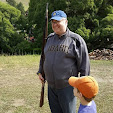Last weekend I hosted a Regimental Fire and Fury game at my house. I don't have a dedicated wargames room anymore (added three kids and moved to a smaller house), so I rarely host. When I do, I like to try something interesting.
Most historians reckon Champion Hill as the most decisive battle of the Vicksburg campaign, but if Pemberton and Johnston were going to beat Grant, they would have had to unite their forces and fight outside of Vicksburg. Grant's victory at Raymond ensured that the two Confederate armies would remain separate. Had Pemberton reacted more forcefully and blocked Grant a Raymond, Grant would have been hard pressed to retain his momentum in the campaign.
I used to have a 9' by 5' ping pong table on which to game, but I have had to come up with something else in my new house. I use my dining room table, then add three plywood panels, each measureing 3' by 5'. I put my gaming mat on top, and I have a pretty functional gaming surface. All the terrain you see is by The Terrain Guy, sadly defunct. The trees are my own, scavenged here and there. I mount them on steel washers, then flock the bases.
At the historical battle, the Confederates fought a delaying action at 14 Mile Creek, with one Confederate brigade taking on a division of McPherson's Union corps. You can see the vital Raymond crossroads in the distance. If Grant is to interpose his army between Pemberton and Johnston, he will need to take Raymond before either Confederate general can react.
I have been reading two
Wargaming in History volumes, covering Bull Run and the Shenandoah Valley campaign. The authors have tweaked Regimental Fire and Fury in some interesting ways. I decided to introduce some of their modifications into this scenario. Most Confederate units started hidden, so I gave Jon a mix of unit markers and dummy markers. Hopefully this would keep the Union commanders on their toes.
There were also two hidden fords over the creek. The Union found one of the fords during the game. Infantry could cross the creek anywhere, taking a full turn to do so. Artillery could cross only on bridges or fords. I classed all the woods as rough terrain, impenetrable to artillery.
The Union brigades entered on these two roads. Don and Scott were our Union commanders, and they chose to focus all their effort on the bridge.
Don and Scott are experienced Fire and Fury players. They've been at this since the original rules came out! With two large brigades of Union veterans, I expected them to make short work of the Confederate cavalry screening the river.
The Confederate cavalry regiments were mostly made up of local home guards and hurriedly gathered fragments of other units. I rated them all trained. Most were armed with shotguns, so they were not much good in a firefight! The single Confederate artillery section harassed the Union troops as they deployed. Jon rolled pretty well with those guns, and the Union had some trouble shaking out into line.

Soon the weight of Union numbers was starting to tell. The Confederate cavalry could not hold, and Jon committed his infantry to the defense of the creek. I had a deck of twelve cards with two aces mixed in. I drew a card for every brigade maneuver roll. An ace of spades caused an immediate lull in the fighting. Both sides pulled back equally until they were 8" away from each other. All disorder and low on ammo markers lifted, and we advanced to the next turn. An ace of diamonds caused any Confederate infantry regiments in charge range to raise a rebel yell, ignore terrain restrictions, and charge the nearest Union unit!
Here is the result of our first ace of diamonds pull. Jon's rebel infantry has left their safe positions and charged the Union juggernaut! The Confederates were duly punished this time.
With the Confederate infantry weakened, Don and Scott made another push against the creek. By now all the Confederate units were revealed. That rebel line had looked pretty easy to break at first. Now it looked much more formidable. The Union generals were trying to overcome the rebels with firepower, but despite having a 5:1 advantage in guns, the Union batteries were mostly silent all game,
Another ace of diamonds, and the rebels crossed the creek again! This time they rolled very well and pushed the Union infantry back. Scott's lead regiments were now worn.
Kevin took over command of the rebel south wing. In his attack, the Union brigade commander fell, mortally wounded.
Jon's northern wing of Confederates attacked the other Union brigade. In his volley, the Union brigade commander was grievously wounded and carried to the rear. In the melee that followed, the Union division commander was hit. The Union regiments gave ground, leaking stragglers to the rear.
With all three of their generals down, a third of their regiments worn, and their attack a shambles, the Union commanders decided to call off the attack and await reinforcements. Our game ended with a minor Confederate victory.






































